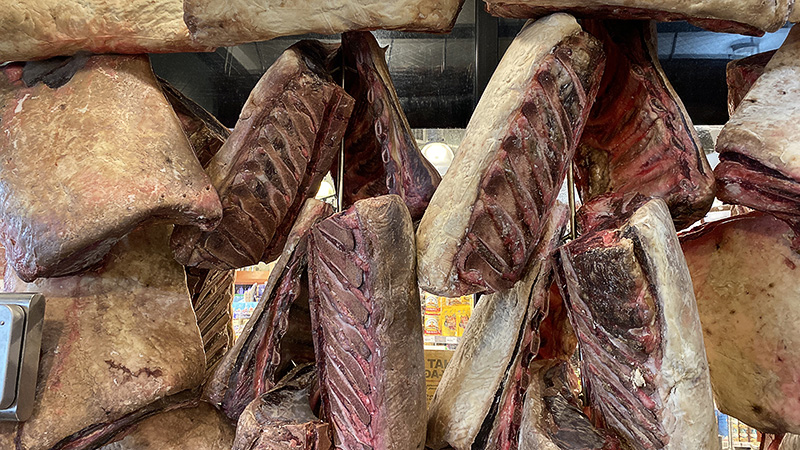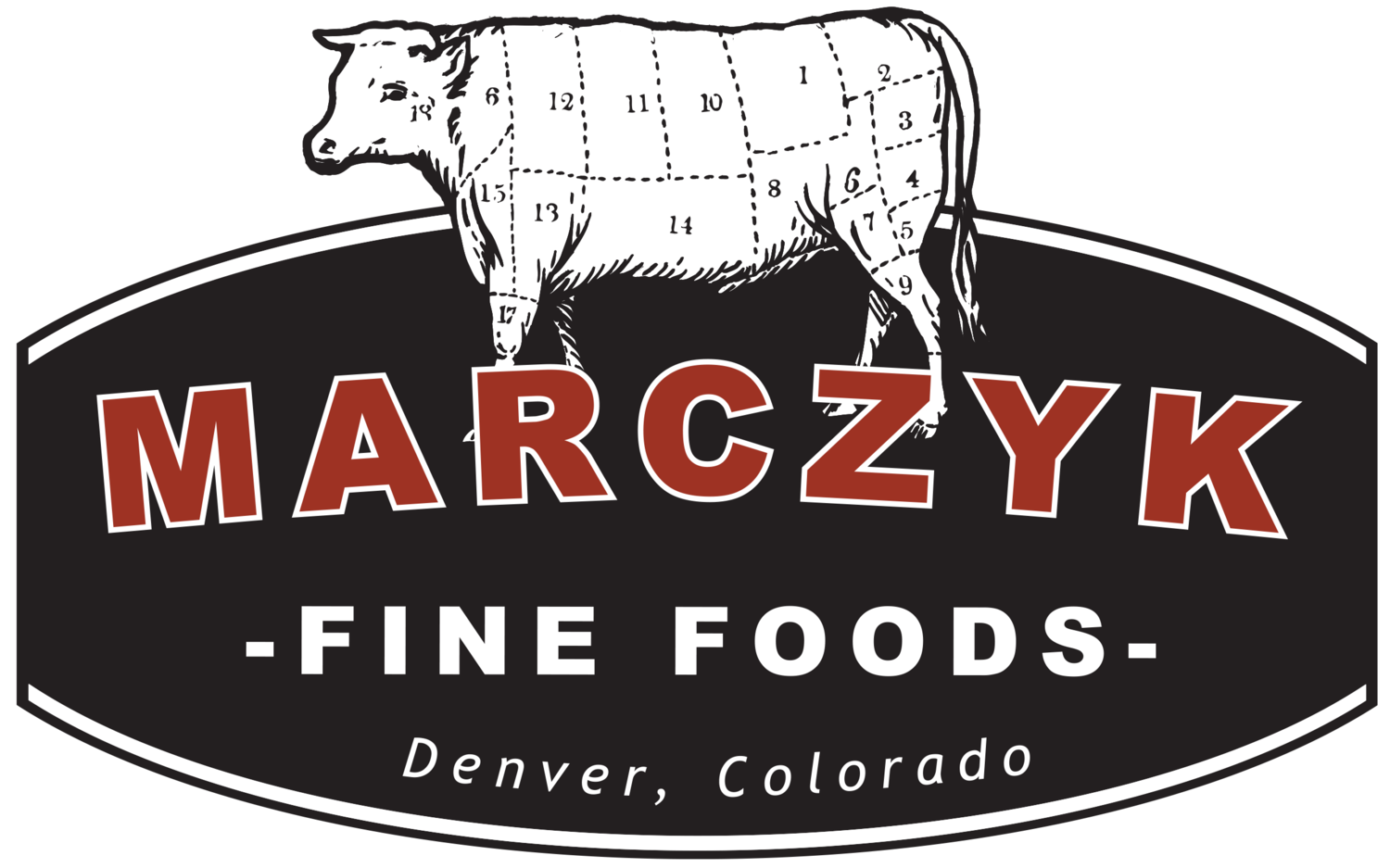What's with Dry-Aged Meat Anyway?
Below we’re featuring two perspectives on dry-aged meat—one from food writer Bill St. John, and one from Pete Marczyk. They will answer some of your questions—why does it cost more? what happens during the process? what is the history of dry-aging? how soon is now?—and you will realize why our dry-aged Niman Ranch beef is our signature item of every year.
BY BILL ST. JOHN
You may remember, if once watching a British period drama on television, a reference by the butler to “well-hung game.” What he (sorry, it was invariably a “he”) was talking about was the traditional practice of aging the meat of pheasant, grouse, or venison, say, for a fairly lengthy period of time—two to three weeks, at a minimum—in the cellar, downstairs of the downstairs. What the hanging well of the game did was to concentrate the meat’s flavors through the inevitable process of the evaporation of the moisture in its flesh.This same process occurs today in meat-aging rooms in which large pieces of beef hang for the same periods of time. In the 21 days of a standard three weeks’ hanging time, for example, up to one-third of a side of beef’s water will simply disappear—let’s call it “the angels’ share”—thereby condensing whatever flavor compounds the water used to surround. (Longer aging times indeed exist, and further the processes discussed here.)
Moreover, enzymatic action within the meat (nowadays, less often game or venison, more commonly lamb or beef) tenderizes it, breaking down muscle fibers and rendering the meat more delicate than it would otherwise be absent the aging.
And furthermore — this is a rather glorious “furthermore” — in a process of fermentation not unlike that in the fashioning and aging of dry sausages, dry-aging triggers the release of amino acids, freeing up what tasters call “umami,” the so-called fifth taste (after the well-known quartet of the tastes bitter, sweet, salt, and sour). Umami is that very pleasant, savory, juicy, salivary taste set off by certain foods such as a nugget of Parmigiano-Reggiano cheese, or a sip of miso soup, or (one of its better epiphanies) grilled or sautéed mushrooms.
Or dry-aged prime rib beef roast. What is commonly purchased at grocery store butcher counters—wet-aged beef—doesn’t make for concentrated flavors (there’s no evaporation), nor the tenderizing of the meat’s musculature, nor any development of umami.
What is commonly purchased at grocery store butcher counters—wet-aged beef—doesn’t make for concentrated flavors (there’s no evaporation), nor the tenderizing of the meat’s musculature, nor any development of umami.
Only dry-aging can do that.
Dry-aging also self-explains its cost: evaporation loses both volume and weight (or what butchers and food people call “product”), and aging time increases the cost of holding inventory.
When what is being dry-aged is itself Prime-level quality, or from pasture-raised animals, or costly on its own merits, that explains its rarity even more.
Nonetheless, and of a matter of course, in a turn on the common steak cooking term, “rare” eats and tastes better hands down.
Moreover, enzymatic action within the meat (nowadays, less often game or venison, more commonly lamb or beef) tenderizes it, breaking down muscle fibers and rendering the meat more delicate than it would otherwise be absent the aging.
And furthermore — this is a rather glorious “furthermore” — in a process of fermentation not unlike that in the fashioning and aging of dry sausages, dry-aging triggers the release of amino acids, freeing up what tasters call “umami,” the so-called fifth taste (after the well-known quartet of the tastes bitter, sweet, salt, and sour). Umami is that very pleasant, savory, juicy, salivary taste set off by certain foods such as a nugget of Parmigiano-Reggiano cheese, or a sip of miso soup, or (one of its better epiphanies) grilled or sautéed mushrooms.
Or dry-aged prime rib beef roast.

Here is an action photo of some of the beef currently dry-aging in our meat cooler. Notice the crusty exterior that forms.
Only dry-aging can do that.
Dry-aging also self-explains its cost: evaporation loses both volume and weight (or what butchers and food people call “product”), and aging time increases the cost of holding inventory.
When what is being dry-aged is itself Prime-level quality, or from pasture-raised animals, or costly on its own merits, that explains its rarity even more.
Nonetheless, and of a matter of course, in a turn on the common steak cooking term, “rare” eats and tastes better hands down.
BY PETE MARCZYK
The flavor of ‘dry-aged’ beef was the norm until widespread refrigeration and the shift from rail transport of whole carcasses to the boxed-beef revolution. This was fueled by the advent of the interstate system, cheap gas, and ubiquitous trucking, which supplanted all previous methods of transport and distribution. Think stockyards and meat-packing districts in cities like Denver, Kansas City, Chicago, New York City—all rail hubs or terminals. There was a simple reason for this old system: Whole-hung beef will keep quite well without refrigeration as long as it is hung “dry,” as in not allowed to touch anything else around it that would impede the formation of a crust (which we in the meat biz call "bark").In fact, the meat inside the bark is literally sterile until it is exposed to air, so that’s why it took such skilled workers to handle the beasts carefully and correctly for transport. It is also the reason that all major cities had meatpacking districts—once the beef was broken down, the shelf-life was short!
Further, it is exactly that dry-hanging (now it’s special and we call it "aging") that made the flavor of American beef so famous around the world. Once we figured out inexpensive mechanical refrigeration, we started marketing unhung, non-aged beef as fresh. As is the case with so many of our wonderful, traditional foods (think cheese, pickles, sauerkraut, salumi…), the modern world of food safety has left us bereft of some of the most wonderful flavors ever known to man. Now, we make sauerkraut with cabbage and vinegar (new kraut)—the real deal is created by way of a slow, natural fermentation which produces lactic and acetic acids in just the right balance (only two ingredients, and it never comes out wrong!). Same for pickles: Almost every pickle that almost everyone reading this has ever eaten is an imposter. Try just once the incredible flavor of a naturally and properly fermented pickle—I could write a chapter on the difference between sour, half-sour, and full-sour pickles, but I digress.
As is the case with so many of our wonderful, traditional foods (think cheese, pickles, sauerkraut, salumi…), the modern world of food safety has left us bereft of some of the most wonderful flavors ever known to man. Now, we make sauerkraut with cabbage and vinegar (new kraut)—the real deal is created by way of a slow, natural fermentation which produces lactic and acetic acids in just the right balance (only two ingredients, and it never comes out wrong!). Same for pickles: Almost every pickle that almost everyone reading this has ever eaten is an imposter. Try just once the incredible flavor of a naturally and properly fermented pickle—I could write a chapter on the difference between sour, half-sour, and full-sour pickles, but I digress.
Further, it is exactly that dry-hanging (now it’s special and we call it "aging") that made the flavor of American beef so famous around the world. Once we figured out inexpensive mechanical refrigeration, we started marketing unhung, non-aged beef as fresh.

Here's another action photo of some of the beef currently hanging and dry-aging in our meat cooler.
